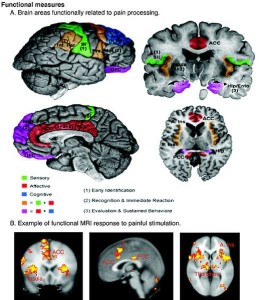 Practical Practitioner
Practical Practitioner
By: Pamela Egan, FNP-C CDE
Integrative Pain Management and How it Affects Your Life
AUGUST 27, 2009 – A recent study reported in the July Journal of Occupational and Environmental Medicine explained that approximately 30 percent of corporate employees have problems with pain. This is linked to reductions in health, work performance, and productivity.
The frequency of pain in the workforce can impact employees’ health and productivity. A considerable percentage of employees report ongoing problems with pain and scored much lower on an overall rating of physical health, compared to those without pain. Pain also reduced their mental health scores. The bottom line is that pain affects nearly every aspect of our lives from productivity, to health-related limitations, absenteeism and work performance, the more severe the pain, the greater its effect on productivity.
 Most employees were dissatisfied with their current pain treatment despite frequent use of pain medications and health care visits, suggesting considerable room for improvement. Pain’s impact on health and productivity was particularly extensive for workers with musculoskeletal conditions. Three of the five most common health problems – neck pain, back pain, and arthritis – fell into this category. Companies are increasingly aware of the financial impact of employee health, not just direct costs such as health insurance, but also indirect costs such as reduced productivity. Effective pain management has become a useful target for employers seeking ways to increase the health and productivity of their workforce.
Most employees were dissatisfied with their current pain treatment despite frequent use of pain medications and health care visits, suggesting considerable room for improvement. Pain’s impact on health and productivity was particularly extensive for workers with musculoskeletal conditions. Three of the five most common health problems – neck pain, back pain, and arthritis – fell into this category. Companies are increasingly aware of the financial impact of employee health, not just direct costs such as health insurance, but also indirect costs such as reduced productivity. Effective pain management has become a useful target for employers seeking ways to increase the health and productivity of their workforce.
This study is a good reflection of the overall population and how they deal with chronic pain. Pain is common (nearly one in three employees) and has a major impact on health and productivity. A focus on musculoskeletal conditions such as spinal pain and arthritis would offer the biggest impact according to researchers. Interventions to lessen the affliction of pain could provide companies with a chance to foster a better quality of life for many employees while at the same time promoting a more productive workforce.
Interventional pain management can include medical and surgical intervention. By investing in a therapeutic partnership and utilizing a myriad of treatments from conventional and alternative systems of medicine, pain can often be lessened and suffering alleviated. The synergistic impact of approaches such as diet, supplements, mind-body strategies, manual therapies, acupuncture, and energetic treatments can augment or at times replace pharmacologic therapies and more invasive procedures.
The use of opiate analgesics or narcotics is not the answer to the treatment of chronic pain. Over-the-counter topical pain relievers such as Biofreeze, once only available at astronomical prices through a chiropractor, physical therapist, massage therapist or other licensed healthcare professional can now be purchased online for a fraction of what people once paid for them. Physicians who specialize in pain management perform many specialized procedures that can relieve chronic pain. They can inject medication directly to the site where the pain originates. Surgical intervention such as neuro surgery, orthopedics, or dental procedures can provide relief to many patients. Non-narcotic medications can also be used to help decrease pain such as anti-depressants, anti-seizure, anti-psychotic and Non-steroidal anti-inflammatory drugs (NSAIDS). Nerve blocks, epidural steroid injections, medial nerve branch blocks, joint injections, nerve root injections are common procedures performed for chronic pain. More advanced procedures such as spinal cord stimulation, drug infusion systems, neurosurgical and permanent anesthetic procedures are used for appropriate candidates. Behavioral or cognitive therapy and counseling are also important components to dealing with chronic pain. All of these examples, as well as the ones listed below, are examples of what is coming to be known as integrative pain management.
National surveys indicate that the use of complementary and alternative medicine in general and dietary supplements in particular, is very high in people with chronic pain conditions. There is a growing body of evidence demonstrating that many botanicals and natural compounds can modulate inflammatory mediators by impacting histamine release, immunoglobulin and cytokine secretions, lymphocyte proliferation, and cytotoxic activity. Essential fatty acids such as Fish Oil, botanical anti-inflammatories, nutraceuticals such as vitamin D3, hypnosis, as well as many other non-invasive techniques can be used in the management of pain.
There is a new active release technique (ART) that many chiropractors are incorporating in their practice. ART was granted a medical patent. It is a clinically studied, evidence-based, Gold Standard soft tissue treatment for muscles, tendons, ligaments, fascia and nerve entrapments. It works on headaches, neck and back pain, carpal tunnel, shin splints, shoulder pain, sciatica, plantar fasciitis, knee and foot problems, tennis elbow and much more. ART providers are trained to palpate and treat more than 300 muscular and fascial injuries and over 100 nerve entrapments, which often cause numbness and tingling. Active Release techniques, as the name implies, uses motion to fix the problem. Once the injury has been assessed, the provider uses hands on treatment and patient motion to “free up” the problem areas. Treatment duration and frequency may vary depending on the severity and complexity of the injury. However, most patients experience rapid recovery, in 4 – 6 treatments. This is a non-invasive treatment and effective method of pain relief.
Acupuncture is powerful medicine which aids in strengthening the immune system and serves to prevent disease, control pain and increase both the ability of function and quality of peoples’ lives. Acupuncture is a well developed whole healthcare system based on natural energetic laws. Dating back over 3,000 years as a primary health care system in China, acupuncture is widespread in Asia, Europe, and now in the U.S. The world health organization of the U.N. identifies over 50 conditions acupuncture treats successfully. As a system of medicine it uses natural laws and energetics with the application of needles and pressure to specific “points” on the body. These points are grouped along certain pathways or meridians that cross the body. As long as the energy flows freely through these pathways, health is maintained. When the flow of energy is either absent, deficient, interrupted, excessive or blocked in an area, health is disrupted, resulting in illness or pain. By stimulating appropriate acupuncture points along these meridians, the energy is released and regulated, and health is restored.
Stem cells are cells that can renew themselves and turn into other cells (differentiate). Most of what you’ve heard about stem cells is about embryonic stem cells. There is much more published data on the properties of adult stem cells. This new ground breaking treatment is being used for knee, hip, and ankle pain, limited range of motion, stiffness, swelling, and tenderness, the feeling that a joint may ‘give out’. Stem Cells are the repairmen of the body and have been used to treat non-healing bony fractures, herniated lumbar (lower back) disc, avascular necrosis (stages 1 – 4) of the shoulder, hip, knee, or ankle, osteoarthritis of the knee, hip, or ankle or degenerative joint disease, partial tear of the rotator cuff, other knee injuries such as a meniscus tear or tear of the ACL or MCL. Stem cells are the “repairmen of the body”. They live inside all of us in various tissues, poised to leap into action to repair damage as it occurs. The problem is that as we age or get big injuries, we often can’t muster enough of these cells to the site to fully repair the area.
The type of adult stem cell that is most often seen in research as being associated with tissue repair is a mesenchymal stem cell (MSC). MSC’s can’t generally be harvested from blood nor can they be obtained in clinically relevant numbers at the bedside, processed and re-injected in the same day. All of the high quality research involving MSC’s involves culture expansion. This means that the cells are grown in culture to higher numbers before being used for treatment. This usually takes 10 – 18 days.
For orthopedic applications, two main types of MSC’s have been used, bone marrow derived and adipose derived. Bone marrow stem cells are taken via a needle through a bone marrow aspirate. The bone marrow aspiration procedure sounds like a big deal, but is consistently described by patients as very comfortable. The second type of MSC is derived from fat tissue (adipose). This can be obtained via liposuction. For orthopedic applications, fat derived MSC’s consistently and dramatically under perform bone marrow derived cells. In studies of cartilage repair, bone repair, and soft-tissue repair, bone marrow derived MSC’s are much more adept at these tasks. For more information contact: http://www.regenexx.com/ or 303-495-4014.
Battling cancer is its own challenge. But when you also have to fight the persistent pain associated with cancer, the challenges you face can be overwhelming. Persistent pain associated with cancer causes discomfort, sleeplessness, and inability to do day-to-day activities. Doctors typically prescribe medications such as morphine and oxycodone for persistent cancer pain relief. However, even with increased medication dosage, some patients still experience constant pain. Additionally, these drugs often include unwanted side effects that prevent patients from taking the higher doses needed to help relieve their persistent pain. Because of this, it is important to develop additional treatments to combat persistent cancer pain. There is a research study that will evaluate Sativex as an add-on treatment for persistent cancer and for possible approval by the U.S. Food and Drug Administration (FDA). Sativex has been approved in Canada as an add-on treatment for pain in patients with cancer.
The presence of chronic pain has a notable influence on primary health care and medication. A range of therapeutic actions are common and are partly overlapping. The use of health care among people with chronic pain depends above all on pain intensity and perception of pain but is also affected by ethnicity, age, socioeconomic level, and depressive symptoms. Among people with chronic pain use of analgesics is common in contrast with other types of pain relief (acupuncture, physiotherapy) suitable for treating chronic pain symptoms.
Check out the pain management chart to learn about alternative therapies that have been shown to help relieve chronic pain. Informing yourself could be your first step on the path to a pain-free life.
– Alternative Pain Management Therapies Chart
Pamela Egan, NP, CDE, ABAAHP Diplomat
1116 W. 21’st Avenue
Covington, LA 70433
Office Phone: 985-892-3031
Pamela Egan, MN, NP, CDE, ABAAHP Diplomat is a board certified Adult & Family Nurse Practitioner, Certified Diabetes Educator, and has completed a Fellowship in Anti-Aging & Regenerative Medicine. She can be reached at 985-892-3031 or www.pamelaegan.com.
Recent Posts:
- – Raynaud’s Disease: Are Cold Hands and Feet Causing You Misery?
- – The Health Benefits of Tea
- – Foods that Heal
- – Natural Remedies for Colds and Upper Respiratory Infections
- – Anti-Aging Medicine: Myth Or Reality?
- – What is Swine Flu and What are its Symptoms?
- – Andropause: Male Menopause Caused By Testosterone Deficiency
Most Read:
- – Coenzyme Q10 (CoQ10) helps prevent disease
- – Vitamin D3 Deficiency
- – Folic Acid Deficiency: The Benefits of L-Methylfolate
- – Female Weight Gain: Why am I Gaining Weight?
PamelaEgan.com > Health Articles > Alternative Medicine

